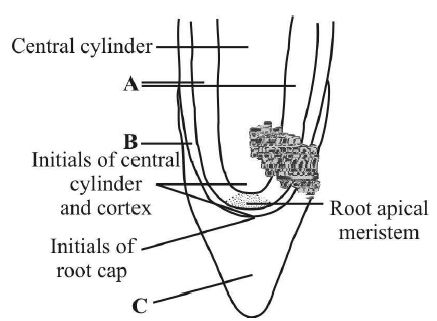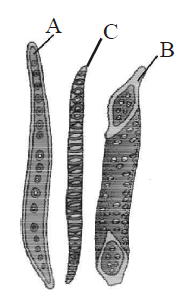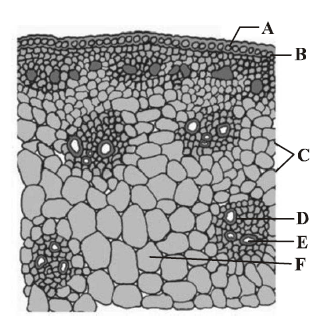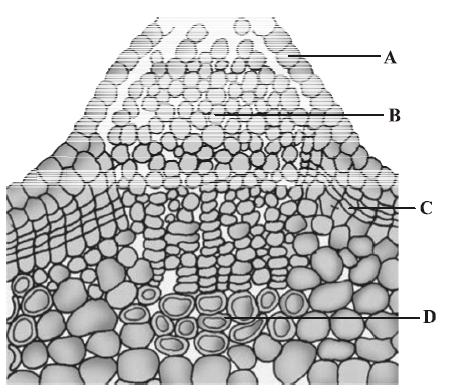A piece of wood having no vessels (trachea) must be belonged to
teak
mango
pine
palm
Correct Answer :
C. pine
Teak, mango and palm belong to angiosperms in which presence of vessels is a characteristic feature. Pine is a gymnosperm which lack vessels in their xylem.
Related Questions
Read the following statements and answer the question.
- Cambium is very active and produces a large number of xylary elements having vessels with wider cavities.
- It is also called early wood.
- It is lighter in colour and has lower density.
Which type of wood is described by the above statements?
Sap wood
Heart wood
Spring wood
Autumn wood
A plant tissue when stained showed the presence of hemicellulose and pectin in cells wall of its cells. The tissue is called
collenchyma
sclerenchyma
xylem
meristem
An organised and differentiated cellular structure having cytoplasm but no nucleus is called _________.
vessels
xylem parenchyma
sieve tubes
tracheids
A common structural feature of vessel elements and sieve tube elements are
pores on lateral walls.
presence of p-protein.
enucleate condition.
thick secondary walls.
A vascular bundle in which the protoxylem is pointing to the periphery is called __________.
endarch
exarch
radial
closed
Which meristem helps in increasing girth?
Lateral meristem
Intercalary meristem
Primary meristem
Apical meristem
Which of the following process helps the trichomes in preventing water loss?
Where companion cells helps in maintaining the pressure gradient in the sieve tubes.
Where plants absorb water through the roots and then give off water vapor through pores in their leaves.
Where activity of cork cambium builds pressure on the remaining layers peripheral to phellogen and ultimately these layers dies and slough off.
None of the above
Trees at sea do not have annual rings because
soil is sandy.
there is climatic variation.
there is no marked climatic variation.
there is enough moisture in the atmosphere.
Cork cambium and vascular cambium are
the parts of secondary xylem and phloem.
the parts of pericycle.
lateral meristems.
apical meristems.
Why grafting is successful in dicots ?
In dicots vascular bundles are arranged in a ring.
Dicots have cambium for secondary growth.
In dicots vessels with elements are arranged end to end.
Cork cambium is present in dicots
The vessel elements of angiosperms differ from other elements of xylem in having
simple pits on their radial walls.
bordered pits on their lateral walls.
simple and bordered pits on their end walls.
simple perforation on their end walls.
Which one of the following have vessels as their characteristic feature?
Angiosperms
Gymnosperms
Pteridophytes
Bryophytes
Match the terms given in column I with their funciton given in column II and choose the correct option.
| Column-I | Column-II |
|---|---|
| (Term) | (Functions) |
| A. Meristem | I. Photosynthesis, storage |
| B. Parenchyma | II. Mechanical support |
| C. Collenchyma | III. Actively dividing cells |
| D. Sclerenchyma | IV. Stomata |
| E. Epidermal tissue | V. Sclereids |
A I, B III, C V, D II, E IV
A III, B I, C II, D V, E IV
A II, B IV, C V, D I, E III
A V, B IV, C III, D II, E I
In an experiment, a student cut a transverse section of young stem of a plant which he has taken from his school garden.
After observing it under the microscope how would he ascertain whether it is a monocot stem or a dicot stem?
With the help of bulliform cells.
With the help of casparian strips.
With the help of vascular bundles.
With the help of stomatal apparatus.
Sclerenchyma usually___________and_____________ protoplasts.
live, without
dead, with
live, with
dead, without
A narrow layer of thin walled cells found between phloem/ bark and wood of a dicot is
cork cambium
vascular cambium
endodermis
both (a) & (c)
The given figure shows apical meristem of root apex with few part marked as A, B and C. Identify the correct labelling of A, B and C.

A Vascular structure, B Protoderm, C Root cap
A Cortex, B Endodermis, C Root cap
A Cortex, B Protoderm, C Root cap
A Tunica, B Protoderm, C Root cap
During the formation of leaves and elongation of stem, some cells left behind from the shoot apical meristem, constitute the
lateral meristem
axillary bud
cork cambium
fascicular cambium
One of the primary function of the ground tissue in a plant is
photosynthesis.
to protect the plant.
to anchor the plant.
water and sugar conduction.
Match the followings and choose the correct option
| Column-I | Column-II |
|---|---|
| A. Cuticle | I. Guard cells |
| B. Bulliform cells | II. Outer layer |
| C. Stomata | III. Waxy layer |
| D. Epidermis | IV. Empty colourless cell |
A III, B IV, C I, D II
A I, B II, C III, D IV
A III, B II, C IV, D I
A III, B II, C I, D IV
In stems, the protoxylem lies towards the _____________ and the metaxylem lies towards the ____________ of the organ.
centre; periphery
periphery; centre
periphery; periphery
centre; centre
In land plants, the guard cells differ from other epidermal cells in having
cytoskeleton.
mitochondria.
endoplasmic reticulum.
chloroplasts.
The given figures are types of elements (A and B) which constitute one type of complex tissue (c) of a plant . Identify A, B and C.

A Tracheid, B Vessel, C Xylem
A Vessel, B Tracheild, C Phloem
A Fibre, B Tracheid, C Bark
A Fibre, B Sclereid, C Casparian strips
The given figure shows T.S. of monocot stem. Identify the correct labelling of A to F marked in the given figure.

A Epidermis, B Hypodermis, C Vascular bundles, D Phloem, E Xylem, F Ground tissue
A Cuticle, B Epidermis, C Sclerenchymatous sheath, D Sclerenchymatous hypodermis, E Parenchymatous sheath, F Phloem
A Cuticle, B Epidermis, C Sclerenchymatous hypodermis, D Sclerenchymatous sheath, E Parenchymatous sheath, F Phloem
A Cuticle, B Epidermis, C Sclerenchymatous hypodermis, D Sclerenchymatous sheath, E Parenchymatous sheath, F Protoxylem
Which one of the followings option shows the correct labelling of the parts marked as A, B, C and D in the given figure a lenticel?

A Epidermis, B Secondary cortex, C Cork cambium, D Cork
A Pore, B Cork cambium, C Secondary cortex, D Cork
A Pore, B Cork, C Complimentary cells, D Cork cambium
A Epidermis, B Complimentary cells, C Cork cambium, D Secondary cortex
Xylem functions as a conducting tissue for water and minerals from _________to the ______and__________.
roots, stems, leaves
stems, roots, leaves
leaves, stems, roots
leaves, stems, leaves
Match the elements of xylem given in column I with their character given in the column II and choose the correct option.
| Column-I | Column-II |
|---|---|
| A. Xylem vessels | I. Store food materials |
| B. Xylem tracheids | II. Obliterated lumen |
| C. Xylem fibres | III. Perforated plates |
| D. Xylem parenchyma | IV. Chisel-like ends |
A IV; B III; C II; D I
A III; B II; C I; D IV
A II; B I; C IV; D III
A III; B IV; C II; D I
Some vascular bundles are described as open because these
are surrounded by pericycle but not endodermis.
are capable of producing secondary xylem and phloem.
possess conjunctive tissue between xylem and phloem.
are not surrounded by pericycle.
The given figure shows the secondary growth in a dicot stem. Their parts are marked as A, B, C, D, E & F. Choose the correct labelling of the parts marked as A to F.

A Phellem, B Phellogen, C Medullary rays, D Secondary xylem, E Secondary phloem, F Cambium ring
A Phellem, B Phellogen, C Medullary rays, D Secondary phloem, E Secondary xylem, F Cambium ring
A Phellogen, B Phellem, C Medullary rays, D Secondary xylem, E Secondary phloem, F Cambium ring
A Phellem, B Phellogen, C Cambium ring, D Secondary xylem, E Secondary phloem, F Medullary rays
Which of the following statements are correct ?
- Xylem transports water and minerals.
- Gymnosperms lack sieve tubes and companion cells in phloem.
- The first formed primary xylem is called metaxylem.
- Phloem fibres (bast fibres) are made up of collenchymatous cells.
(i) and (iii)
(i) and (ii)
(iii) and (iv)
(i) and (iv)
